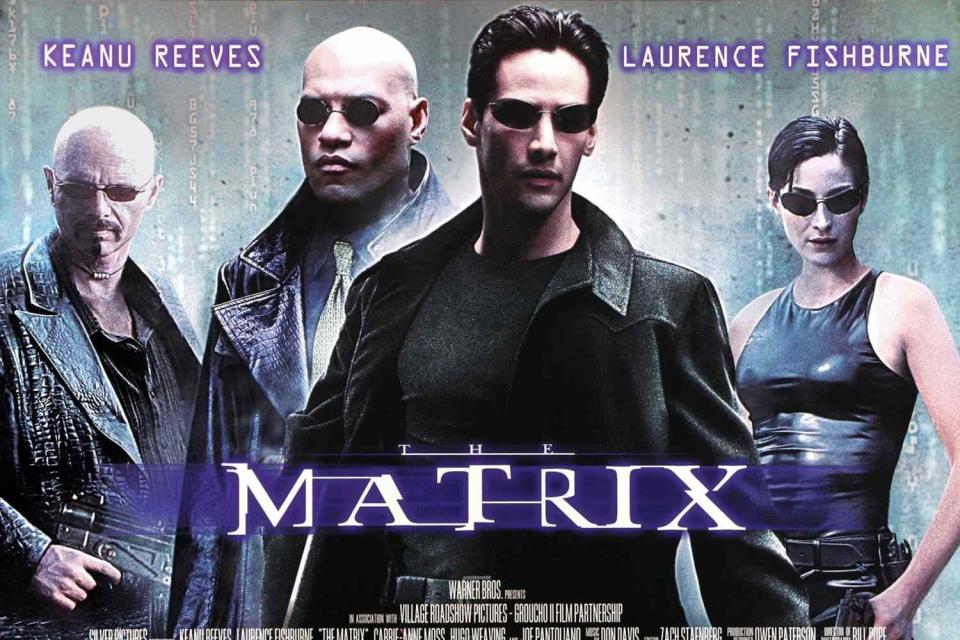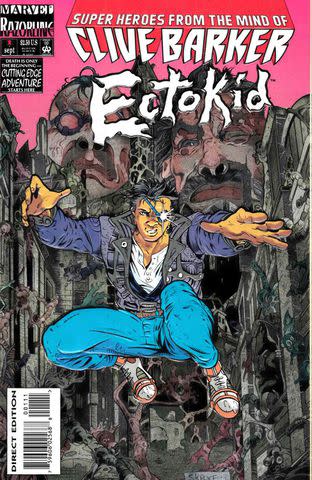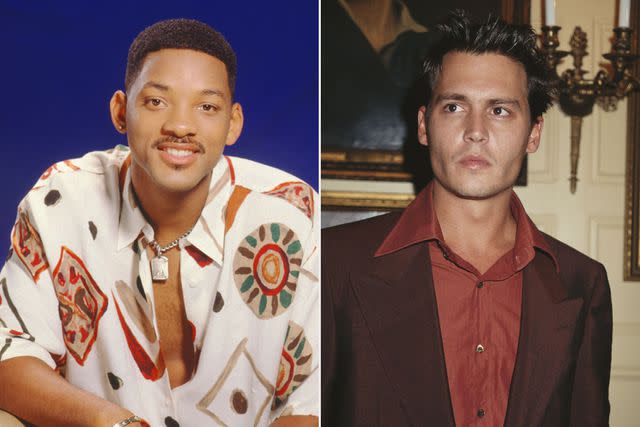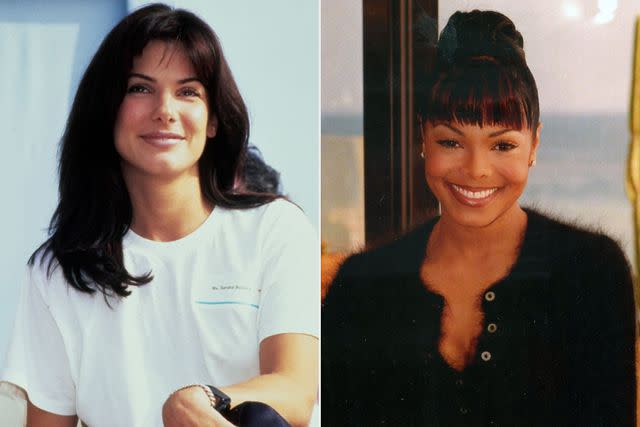“The Matrix ”at 25: All the Stars Who Rejected Roles and More Facts About the Action Classic
- Oops!Something went wrong.Please try again later.
- Oops!Something went wrong.Please try again later.
- Oops!Something went wrong.Please try again later.
- Oops!Something went wrong.Please try again later.
- Oops!Something went wrong.Please try again later.
- Oops!Something went wrong.Please try again later.
Learn about Keanu Reeves’ intense training, the one shot that cost $750,000, why Janet Jackson passed on playing Trinity and the film’s bizarre connection to a murder trial

The release of The Matrix could not have been better timed. It was March 1999, an era when the early promise of the internet was tempered by Y2K and the fear of a techno-triggered apocalypse. Lines between reality and virtual reality were becoming blurred, and writer/director siblings Lilly and Lana Wachowski captured the thrills and anxiety of the era with a groundbreaking feature that brought their comic book sensibilities to the big screen.
One of the most iconic film franchises of the past quarter-century, The Matrix blended old-school martial arts and action-movie fundamentals with a philosophical understanding of how the growing digital world would affect us all. Keanu Reeves’ Neo and Carrie-Anne Moss’ Trinity became THE movie heroes of the ‘90s, inspiring a generation to don leather trench coats and ultra-thin sunglasses and pretend they know kung-fu. The elaborate world-building and precinct plot yielded a timeless film that would be studied and enjoyed for decades to come.
To mark the 25th anniversary of its release, read on to learn more about this sci-fi action classic. And for more behind-the-scenes stories and little-known details about The Matrix, check out the recent episode of the iHeartRadio podcast Too Much Information, hosted by former PEOPLE editors Jordan Runtagh and Alex Heigl.
Related:
Neo has his origins in a comic book.

marvel
Early Neo inspiration Dex MungoBorn in the mid-’60s, Lily and Lana Wachowski were raised in Chicago, where high school classmates remember them as Dungeons and Dragons players who were deeply invested in their theater program and student-run TV station. By the late ‘80s, they had both dropped out of college to pursue their dreams of creative writing.
Elements of The Matrix came from the Wachowskis' days working at the Marvel comics imprint Razorline in 1993. Writing for Ectokid, a series created by legendary horror author Clive Barker, they devised the character Dexter Mungo, who gains the ability to travel freely in the dimension of the dead by leaving his physical body behind — much like Neo does.
The cast were given a reading list to understand the script.
An early version of the The Matrix screenplay was completed by 1994 and would ultimately undergo upwards of a dozen rewrites to iron out the complexities of the plot and the world the Wachowskis created, which drew from a dazzling array of sources.
“The script was a synthesis of ideas that sort of came together at a moment when we were interested in a lot of things: making mythology relevant in a modern context, relating quantum physics to Zen Buddhism, investigating your own life," Lilly Wachowski told The New York Times in 1999. "We started out thinking of this as a comic book. We filled notebook after notebook with ideas. Essentially that's where the script came from.''
These ideas bore traces of the Wachowskis’ diverse interests. They had read Homer’s epic poem The Odyssey multiple times, along with groundbreaking "cyberpunk" works by William Gibson and Philip K. Dick. They grew up watching a canonical cross-section of 20th-century film, including works by Stanley Kubrick, John Huston, Billy Wilder, Ridley Scott, George Lucas, Jean-Luc Godard's 1965 French sci-fi noir Alphaville and Fritz Lang's Metropolis — along with anime classics like Ghost in the Shell and Hong Kong action films.
Central to The Matrix plot was Plato’s “Allegory of the Cave,” in which a group of people chained in a cave watch the shadows projected by a fire lit behind them; they perceive the shadows as reality but do not know their true form. In addition to philosophical concepts by philosophers like Renes Decartes and Jean Baudrillard, The Matrix also drew on elements of Hinduism, Buddhism, Gnosticism, Judaism and Christianity.
In an effort to help the cast grasp nuances of the script, the Wachowskis handed out a reading list prior to shooting, with titles including Simulacra and Simulation by French philosopher Jean Baudrillard and Kevin Kelly's Out of Control: The New Biology of Machines, Social Systems, and the Economic World.
The Wachowskis pitched the script with a 600-page comic book.
Shopping the dense script around Hollywood proved to be an uphill battle for the Wachowskis. An action movie that featured multiple philosophical threads and a combination of religious imagery from both the East and West, all set in a dystopian future and dotted with cyberpunk jargon did not make for the most executive-pleasing project.
"Every single person in town rejected it," Lana Wachowski told Buzzfeed. Eventually the script landed in the hands of producer Joel Silver, who found himself immediately captivated. "The minute I started reading the script for The Matrix, I wanted to see it,” he recalled to Wired in 2003.
To help sell the movie to studios, the Wachowskis created a 600-page, scene-by-scene comic book based on their script, which they laid out for the top brass at Warner Bros. Executive Lorenzo di Bonaventura would recall their presentation as “unusual” — to put it mildly. "One of the Wachowskis was explaining the story, and the other was making sound-effect noises," he later told Wired.
Will Smith was almost Neo — and so was Johnny Depp!

getty (2)
Will Smith and Johnny Depp, early casting choices for NeoKeanu Reeves was far down the list of stars considered to lead The Matrix. According to Matrix composer Don Davis, the Wachowskis initially had their eye on another heartthrob to anchor their movie. “Johnny Depp was their first choice for Neo,” Davis said in a 2004 interview. “Warner Bros. ... didn't want Johnny Depp — they wanted Brad Pitt or Val Kilmer." Both passed, as did Nicolas Cage, who turned down the part because of "family obligations."
Will Smith was considered for the role of Neo, but he backed out because he felt he wasn't "mature enough as an actor" at that time, and he "would have messed it up." (He made Wild Wild West instead.) Leonardo DiCaprio was also signed on at one point but got spooked by the extensive visual effects the film promised — which is understandable since he’d just undergone a prolonged stay in a watery hell called Titanic shepherded by James Cameron.
Ultimately, Reeves won out. He told Wired of The Matrix, "When I first read that script, it made my blood happy."
Sandra Bullock was almost Trinity — and so was Janet Jackson!

getty (2)
Sandra Bullock and Janet Jackson, early casting choices for TrinityReeves’ Speed costar Sandra Bullock was considered for the role of Trinity. In fact, producers were so desperate to have her in the film that they reportedly offered to swap the gender of the lead role. “We went to Sandy Bullock and said ‘We’ll change Neo to a girl,’" Warner Bros. executive Lorenzo di Bonaventura told The Wrap in 2019. "It was pretty simple. We sent her the script to see if she was interested in it. And if she was interested in it, we would try to make the change. It just wasn’t something for her at the time. So really it didn’t go anywhere.”
Janet Jackson was also approached to play Trinity, but she had to back out due to scheduling commitments. She would apparently come to regret the decision, and referenced The Matrix in the “Intro” and “Outro” interludes on her 2008 album Discipline. Rosie Perez, Salma Hayek and Jada Pinkett Smith also auditioned, but producers decided to go with the then relatively unknown Carrie-Anne Moss. "I had no career before," Moss admitted to Entertainment Weekly in 2003. "None." The part would catapult her to stardom.
The Wachowskis met their Morpheus at the fight where Mike Tyson bit Evander Holyfield.
Warner Bros. wanted to cast Val Kilmer in the role of Morpheus, but initial talks with the actor were not promising. "We have a meeting with him at the Bel-Air Hotel, where he proceeds to pitch why Morpheus should be the lead of the movie," studio executive Lorenzo di Bonaventura told Wired. "I knew within two minutes of the meeting we were dead.” Arnold Schwarzenegger and Michael Douglas were approached, but they both declined. Gary Oldman was also in the running before WB went with the Wachowskis’ first choice for the part: Laurence Fishburne.
The pair had met Fishburne in Las Vegas in the summer of 1997, at the boxing match in which Mike Tyson had bit off part of Evander Holyfield's ear. "I had a dream about a man who wore mirrored sunglasses and spoke in riddles," Lana Wachowski would later tell Fishburne, "and when I met you and heard your voice, I knew that you were that guy." Fishburne was undaunted by the dense script when first presented with it. He told Vulture in 2020, "I never had any questions about whether or not it worked structurally, thematically or anything on the page. There were no red flags on the page for me at all, and then when I met Lana and Lilly, they said they wanted to make a live-action anime. I was like, 'Yes, please.'"
He thought of the character as a mix of Darth Vader, Yoda, Obi-Wan, Muhammed Ali and Bruce Lee, and arrived at Morpheus' stentorian voice by combining Rod Serling, Leonard Nimoy and James Earl Jones. The Wachowskis also told him to base the performance on the character with the same name in Neil Gaiman's famous comic book series Sandman.
The principal cast underwent four months of exhaustive physical training.
At one of their first meetings, the Wachowskis told Keanu Reeves they'd need him to undergo four months of training for fight choreography and Hong Kong-style wire work. Reeves was game — “I got a big grin on my face and said, 'Yes.'" Unfortunately, by the time he was due for training, he’d recently undergone emergency spinal surgery to treat a herniated disc. "I was falling over in the shower in the morning, because you lose your sense of balance," he recalled to Wired. He arrived in Burbank for training wearing a neck brace and was forbidden from even kicking for the first few months while he recovered.
Moss had a taste of the exhaustive process during her audition, when she was put through a three-hour physical test and nearly a week of stunt screen tests, after which, she told Wired, "I couldn't walk for days." Hugo Weaving, who played the sinister Agent Smith, injured his femur not long into training, leaving him on crutches before he could heal. "After the first day, I was so shattered and so shocked," Hugo Weaving told Wired. "I realized I was so unfit." (Weaver got off relatively easy. Reeves’ stuntman, Chad Stahelski, suffered a dislocated shoulder, damaged knees and several broken ribs while filming.)
Keanu Reeves lost 15 pounds for one scene.
Everyone involved with the production is quick to praise Keanu Reeves’ work ethic and intense dedication to the project. Stunt coordinators recall him asking to train on his days off, obsessively seeking to perfect his form with wires and fighting. The actor even lost an additional 15 pounds just for the scene where he wakes up in the tub of goo, to look properly emaciated.
Joe Pantoliano didn’t bother to read the script and embarrassed himself in front of the Wachowskis.
Actor Joe Pantoliano (who played Cypher, the turncoat) managed to avoid the strenuous physical training in a novel way: surgery. "They wanted me to be in the best shape of my life," he told Wired. "No drinking, eating steamed vegetables, working out at a gym.” His coach was a little less optimistic and delivered a hard truth to the then 40-something actor: “This trainer they hired said to me, 'You can do three thousand sit-ups a day, but that ain't going nowhere’” — gesturing to his gut. Instead, Pantoliano opted for a $8,000 liposuction treatment. He sent the bill to the studio, claiming the procedure technically counted as “research and development.” (Warner Bros. felt differently, and he was not reimbursed.)
Pantoliano had an embarrassing moment when it became apparent during an on-set meeting that he hadn’t actually read the script. The Wachowskis told him that Warner Bros. wanted to cut “the steak scene” — Cypher's most memorable monologue — but Keanu Reeves was pushing back. Since he hadn't read the script, Pantoliano assumed this was a Reeves-heavy scene: “They said, ‘Keanu’s really upset, and he’s telling them they can’t cut it.’ I said, ‘Well, tell him to get the f--- over it. He’s in 99 percent of the movie.’ They just started laughing because they realized I hadn’t read it.”
The “Bullet Time” sequence required 99 cameras, two years and $750,000.
The most infamous instance of “movie magic” in The Matrix is "bullet time," the Wachowskis' term for visualizing how the characters could move at superhuman speeds as the camera orbits around them. They evocatively described the effect in their shooting script: "We enter the liquid space of— Bullet-time. The air sizzles with wads of lead like angry flies as Neo twists, bends, ducks just between them … Neo bent impossibly back, one hand on the ground as a spiraling gray ball shears open his shoulder." This all sounded good on paper, but the Wachowskis had no idea how they’d be able to pull it off on the big screen. "People would say, 'Well, how are you gonna do that?'" Lana told Wired. "And we were like, 'We're working on it.'"
Enter Mass Illusions, an SFX company later renamed Manex Visual Effects. They'd just won an Oscar for creating the afterlife that Robin Williams traverses through in What Dreams May Come, though the Wachowskis initially met with the company's Kim Libreri and John Gaeta to talk as early as 1996, when their script was still being fine-tuned. Gaeta told Empire Magazine, "As for artistic inspiration for bullet time, I would credit Otomo Katsuhiro, who co-wrote and directed Akira, which definitely blew me away, along with director Michel Gondry.… His music videos experimented with a different type of technique called view-morphing."
The scene described in the shooting script takes place during the rooftop shootout. Reeves was on an all-green soundstage in Sydney, wired up to 99 (some reports say 120) still cameras that were descending around him in a spiral. As wires pulled him backwards, the cameras quickly went off in succession around him, while a pair of regular film cameras captured his movements. The still cameras triggered along the mapped path, and each of those photos would be scanned into the computer. This created a strip of still images similar to animation cels, which were strung together with "in-between images" generated by a computer. These images, plus the background and bullets, were combined over the course of nearly two years at a cost of $750,000 to create the scene in the final film.
The green text code has a delicious secret. Maybe.
The cascading green code used to render The Matrix in the real world was a custom typeface designed by Simon Whiteley. The font included Japanese characters, Arabic numerals and Western Latin letters. In a 2017 CNET interview, he attributed the design to his wife, who is from Japan, saying, "I like to tell everybody that The Matrix's code is made out of Japanese sushi recipes." (No word on whether he was kidding.)
The Wachowskis were accused of plagiarism after the film’s release.

Tytus Zmijewski/EPA-EFE/Shutterstock
The Wachowski sistersThe Matrix opened in US theaters on March 31, 1999, taking in over $460 million on a $63 million budget to become the highest-grossing Warner Bros. film of 1999 and the fourth-highest-grossing film of that year. But as with any world-conquering success, the naysayers came out in force. Allegations of plagiarism were leveled at the Wachowskis for lifting bits and pieces of The Matrix from varying sources.
One of the most prominent critics was comic book legend Grant Morrison, whose work had been tackling many of the themes of The Matrix for years. A 1992 issue Morrison’s Doom Patrol features a character who comes to realize he is stuck in an artificial reality called “The Data Matrix,” before journeying to find a way to ascend to reality.
Morrison also noticed similarities to his Invisibles series, in which a secret group of rebels roam multiple planes of reality, imploring the audience to wake up to the inhuman masters who are controlling the real world. The protagonist of The Invisibles is a reincarnation of the Buddha referred to as The One, and it features a scene in which a man jumps off a skyscraper as an initiation ritual — much like Neo does in The Matrix. Morrison also felt his leather-clad characters, steeped in goth and raver subcultures, looked more than a touch like the heroes of The Matrix.
In one extensive interview for the book Anarchy for the Masses: A Disinformation Guide to The Invisibles, Morrison talked about seeing his ideas appear in the mainstream: "Suddenly I felt my territory invaded. That was stuff that nobody had even been doing in comic books or in pop culture.… The Invisibles was on the set [of The Matrix]. People who were there have told me [the Wachowskis] are comic fans. They were Vertigo [the imprint that published The Invisibles] fans in particular." The Wachowskis have not commented publicly about this aspect of their work.
The plot has been successfully used as a courtroom defense for murder.
The film gave rise to “The Matrix Defense,” a form of insanity plea that's been used several times in criminal cases, with the defendants justifying their actions by saying that they believe they were plugged into the Matrix. It's actually worked a few times: Tonda Lynn Ansley of Hamilton, Ohio, was found not guilty by reason of insanity when she used this defense after fatally shooting her landlady in the head in July 2002. Vadim Mieseges of San Francisco also offered a Matrix explanation to police after murdering his landlady, and he was declared mentally incompetent to stand trial. It was also the defense strategy of Joshua Cooke's lawyers in his 2003 trial for the murder of his adoptive parents before he pleaded guilty.
The Matrix has been embraced by the LGBTQ+ community as a trans allegory.
Since they both came out as trangender in the 2010s, the Wachowskis have become vocal about the film's roots in the trans experience. Lilly Wachowski told the website Them: "[The Matrix] is a trans allegory in that it was written by two closeted trans women. And so all of the things that are in it are super-duper trans.… With all the decisions we made with that film, there’s just this burbling transness simmering below everything.… It’s not like these were conscious decisions, but more like we’re finding our way instinctively as these two closeted trans women.... When people say, 'Oh, it’s a trans allegory,' it’s like, 'Yeah, it is, but we weren’t like, 'Hey, let’s write a trans allegory.' That’s not how it started. We were like, 'Hey, let’s write this action film,' and then we got our trans all over it." (The Wachowskis would go on to create Sense8, a sci-fi series featuring trans woman Nomi Marks.)
Emily VanDerWerff, a critic who's written eloquently about the trans themes in The Matrix, spoke to NPR in 2021 about the film’s importance to the trans community. "If you are a trans person, there is sort of this idea that you are living in a muffling cocoon that is keeping you from seeing the reality of yourself. And that cocoon, to some degree, is the idea of fixed gender identity, which is one that society is built atop. To be trans, you have to sort of assail that idea. And in the process of doing so, you may question other things about reality.”
For more People news, make sure to sign up for our newsletter!
Read the original article on People.

